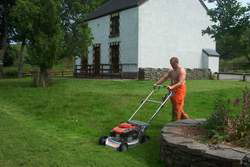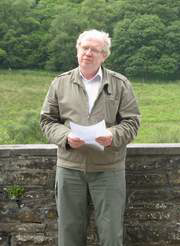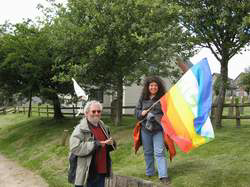Abandoned Communities ..... Mynydd Epynt
The training area also has non-military uses. 93 sheep owners have grazing rights, several of them descendants of the farmers who departed in 1940. The sheep graze in the summer, returning to their farms outside the range during the winter. They number roughly forty thousand, and farmers are charged £2.50 per head per year for the right to graze them. They are not excluded from the Impact Area, and from time to time they become casualties. I have not been able to ascertain whether these incidents are always accidental. The view is taken that the farmers are aware of the risk, and therefore no compensation is paid when a sheep dies.
No other livestock are permitted in SENTA. In the early years horses used to wander into the area. One was spotted in 1954 and promptly shot.
The Ministry of Defence has two other major objectives at Epynt, namely the conservation of vegetation, bird life, insects, amphibians, and small mammals, and to make a presumption in favour of public access. With regard to conservation, the area contains three Sites of Special Scientific Interest. 173 types of trees and plants have been recorded, there are at least ninety species of birds, and over fifty types of fungus, the most celebrated being the wax-cap mushroom. Red squirrels and wild mink have been seen. A conservation centre has been opened at Disgwylfa.
Members of the public can usually drive across SENTA not only on the B4519 but also on a minor road that leaves the A40 just west of Trecastle, crosses Mynydd Bwlch-y-groes close to the main area of forestry, and takes you to the village of Tirabad. This and other roads are also used for rallying. In particular the Network Q Rally of Great Britain, usually the last event in the World Championship, comes this way, and a base is provided here. Owners of other vehicles can seek permission to use parts of the area, but motorbikes and four wheel drive vehicles are not popular as they tend to be driven off the roads and may damage the surface of the ground.
On the whole SENTA officials are happier if you stay on foot. Several walks have been devised, and a lot of work has gone into developing the Epynt Way which will eventually allow the public to walk around the perimeter of the entire area.
If you have time for a walk around SENTA use the excellent guided tour provided on the Discovering Britain website. Or for a lot more photographs of the Training Area, taken by Tarquin Wilton-Jones in August 2010, go to the CavingUK website.
Now and then staff at SENTA have to deal with complaints from the public. People have been upset by the noise produced by training activities. The loudest protests came during the Foot and Mouth epidemic in 2001, when SENTA was used to incinerate a large number of cattle. Clouds of dense smoke were seen coming from the pyres, and brown water was detected in local streams.
From time to time members of Cymdeithas y Cymod visit the Sennybridge Training Area. Cymdeithas y Cymod is the Welsh branch of the International Fellowship of Reconciliation. Their aim is to promote peaceful methods of resolving conflict. They go to SENTA to maintain the memory of the people who lived there and to hold a service of repentance for the use of the land for military training. They notify the Ministry of Defence that they intend to go, but do not ask for permission. Their visits begin with a picnic at the Drovers’ Arms, and then the group travels to the site of Babell chapel for the service of repentance. They may then take a look at the site of Cilieni school and walk around the FIBUA village.
Go to Mynydd Epynt. Make up your own mind about the place.
No other livestock are permitted in SENTA. In the early years horses used to wander into the area. One was spotted in 1954 and promptly shot.
The Ministry of Defence has two other major objectives at Epynt, namely the conservation of vegetation, bird life, insects, amphibians, and small mammals, and to make a presumption in favour of public access. With regard to conservation, the area contains three Sites of Special Scientific Interest. 173 types of trees and plants have been recorded, there are at least ninety species of birds, and over fifty types of fungus, the most celebrated being the wax-
Members of the public can usually drive across SENTA not only on the B4519 but also on a minor road that leaves the A40 just west of Trecastle, crosses Mynydd Bwlch-
On the whole SENTA officials are happier if you stay on foot. Several walks have been devised, and a lot of work has gone into developing the Epynt Way which will eventually allow the public to walk around the perimeter of the entire area.
Now and then staff at SENTA have to deal with complaints from the public. People have been upset by the noise produced by training activities. The loudest protests came during the Foot and Mouth epidemic in 2001, when SENTA was used to incinerate a large number of cattle. Clouds of dense smoke were seen coming from the pyres, and brown water was detected in local streams.
From time to time members of Cymdeithas y Cymod visit the Sennybridge Training Area. Cymdeithas y Cymod is the Welsh branch of the International Fellowship of Reconciliation. Their aim is to promote peaceful methods of resolving conflict. They go to SENTA to maintain the memory of the people who lived there and to hold a service of repentance for the use of the land for military training. They notify the Ministry of Defence that they intend to go, but do not ask for permission. Their visits begin with a picnic at the Drovers’ Arms, and then the group travels to the site of Babell chapel for the service of repentance. They may then take a look at the site of Cilieni school and walk around the FIBUA village.
Go to Mynydd Epynt. Make up your own mind about the place.
Six
Maintenance at Disgwylfa
The service of repentance held by Cymdeithas y Cymod
Gyto Prys ap Gwynfor leading the service of repentance
Members of Cymdeithas y Cymod



